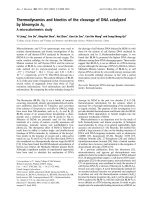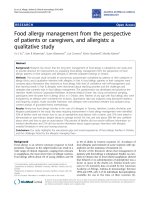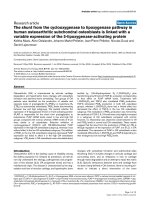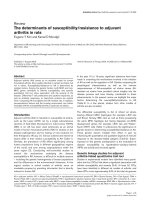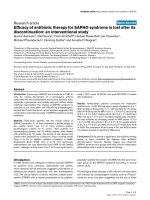Báo cáo y học: " Factors associated with late presentation to HIV/AIDS care in South Wollo ZoneEthiopia: a case-control study" pps
Bạn đang xem bản rút gọn của tài liệu. Xem và tải ngay bản đầy đủ của tài liệu tại đây (209.82 KB, 6 trang )
RESEARCH Open Access
Factors associated with late presentation to
HIV/AIDS care in South Wollo ZoneEthiopia:
a case-control study
Yeshewas Abaynew
1
, Amare Deribew
2
, Kebede Deribe
3*
Abstract
Background: Access to free antiretroviral therapy in Sub-Saharan Africa has been steadily increasing. The success
of large-scale antiretroviral therapy programs depends on early initiation of HIV/AIDs care. The purpose of the
study was to examine factors associated with late presentation to HIV/AIDS care.
Methods: A case-control study was conducted in Dessie referral and Borumeda district hospitals from March 1 to
31, 2010, northern Ethiopia. A total of 320 study participants (160 cases and 160 controls) were included in the
study. Cases were people living with HIV/AIDS (PLHA) who had a WHO clinical stage of III or IV or a CD4
lymphocyte count of less than 200/uL at the time of the first presentation to antiretroviral treatment (ART) clinics.
Controls were PLHA who had WHO stage I or II or a CD4 lymphocyte count of 200/uL or more irrespective of
clinical staging at the time of first presentation to the ART clinics of the hospitals cases and controls were
interviewed by trained nurses using a pre-tested and structured questionnaire. In-depth interviews were conducted
with ten health workers and eight PLHA.
Results: PLHA who live with their families [OR = 3.29, 95%CI: 1.28-8.45)], lived in a rented house [OR = 2.52, 95%CI:
1.09-5.79], non-pregnant women [OR = 9.3, 95% CI: 1.93-44.82], who perceived ART have many side effects [OR =
6.23, 95%CI:1.63,23.82)], who perceived HIV as stigmatizing disease [OR = 3.1, 95% CI: 1.09-8.76], who tested with
sickness/symptoms [OR = 2.62, 95% CI: 1.26-5.44], who did not disclose their HIV status for their partner [OR = 2.78,
95% CI: 1.02-7.56], frequent alcohol users [OR = 3.55, 95% CI: 1.63-7.71] and who spent more than 120 months with
partner at HIV diagnosis[OR = 5.86, 95% CI: 1.35-25.41] were significantly associated with late presentation to HIV/
AIDS care. The qualitative finding revealed low awareness, non-disclosure, perceived ART side effects and HIV
stigma were the major barriers for late presentation to HIV/AIDS care.
Conclusions: Efforts to increase early initiation of HIV/AIDS care should focus on addressing patient’s concerns
such as stigma, drug side effects and disclosure.
Introduction
Sub-Saharan Africa remains the most affected region
in the global AIDS epidemic; with an estimated
22.5 million people living with HIV [1]. The health sta-
tus of HIV positive individuals at the time of antiretro-
viral ( ART) initiation plays a crucial role in the s uccess
of treatment [2-6]. HIV positive individuals with
advanced HIV disease at the time of ART initiation are
less likely to respond to treatment, are more likely to
pose financial strain on health services, and have a
higher mortality rate compared to those who initiate
earlier [2-4]. In addition, late presentation poses a
higher cumulative risk of HIV transmission to others,
considering that earlier presentation and HIV-suppres-
sing treatment might otherwise reduce viral load and
risk of transmission [5]. A large proportion of HIV-
infected individuals in the developed world, roughly
15%-43%, present at clinics for care with advanced or
severe disease (WHO stage 3 or 4 or CD4 lymphocyte
count ≤ 200 cells/uL) [7].
The introduction of ART has offered hope to people
living with HIV/AIDS and has been credited with
* Correspondence:
3
American Refuge Committee International, South Darfur, Nyala, Sudan
Full list of author information is available at the end of the article
Abaynew et al. AIDS Research and Therapy 2011, 8:8
/>© 2011 Abaynew et al; licensee BioMed Central Ltd. This is an Open Access article distributed under the terms of the Creative
Commons Attribution License (http://creativecommon s.org/licenses/by/2 .0), which permits unrestricted use, distribution, and
reprodu ction in any medium, provided the original work is properly cited.
improving the quality of life significantly and reducing
mortality. However, access to ART remains limited,
especially in developing countries, in Sub-Saharan Africa
[8].
Late presentation prevents people living with HIV/
AIDS from obtaining the maximal benefit of being
screen ed for tuberculosis and sexually trans mitted infec-
tions, receiving timely antiretro viral therapy, and benefit-
ing from educational and prophylactic interventions that
are more effective when implemented earlier and that
can prevent further infec tions [5] . HIV infection without
antiretroviral therapy in the vast majority of infected
individuals progressively destroys the immune system
leading to opportunistic diseases and death [9,10].
The reason for late presentation is not clearly studied in
Ethiopia. There are multiple factors associated with delay
to seek care and treatment, including delay in HIV testing
and delay in accessing care once HIV status is known.
Exploring the barriers of early HIV/AIDS care will help
decision makers to improve the access to HIV treatment.
The purpose of this study was to explore the demographic,
behavioral and clinical barriers to HIV/AIDS care.
Methods
A case control study was conducted from March 1-31,
2010 in Dessie referral hospital and Borumeda district
hospital in south Wollo Zone, north-east Ethiopia.
South Wollo is one of the 11 zones of Amhara regional
state. The zone is found in the north-east part of Ethio-
pia. In the hospitals, voluntary counseling and testing
(VCT), prevention of mother to child transmission
(PMTCT), ART and treatment of opportunistic infection
services are a vailable. The study population consisted of
sampled cases and controls who had visited HIV/AIDS
care in the ART clinic of the hospitals during data col-
lection period. Cases were HIV positive individuals who
had WHO clinical stage III or IV irrespective of CD4
lymphocyte count or a CD4 lymphocyte count of less
than 200/uL irrespective of clinical staging at the time
of first presentation to the ART clinics of the hospitals.
Controls were HIV positive individuals who had WHO
stage I or II or a CD4 lymphocyte count of 200/uL or
more irrespective of clinical staging at the time of first
presentation to the ART clinics of the hospitals.
The sample size was calculated using Epi info version
3.3.2.0 by considering the following assumptions: the
proportion of literate individuals among the controls
58% [8], 95% CI, 80% power and case to control ratio of
1:1 to detect an odds ratio of 2.0. The total sample size
was 320(160 ca ses and 16 0 controls). Previous studies
have indicated that educated individual’spresentthem-
selves early for ART. Educational status was chosen as
an independent variable since it gave maximum sample
size.
HIV positive individuals were classified into two
groups based on their CD4 lymphocyte count and
WHO clinical HIV staging at the time of first presenta-
tion to the ART clinics of the hospitals. Source popula-
tion for cases and controls were identified by reviewing
the initial clinic visit medical records at the ART clinics.
From the source population of cases and contro ls, the
study populations (160 cases and 160 controls) we re
randomly selected using simple random sampling tech-
nique. Unique patients’ identification numbers in the
ART clinics were used as a sampling frame for the sim-
ple random selection process. HIV positive individuals
less than 15 years of age and who received prior HIV/
AIDS care were excluded from the study. The selection
of cases and control in the s tudy hospitals is described
in Table 1. The data were collected by trained ART
case managers and ART nurses using an interviewer-
administered, pre-coded and pre-tested structured ques-
tionnaire to address the necessary information. The
questionnaire was developed in English after reviewing
relevant literatures and it was translated into Amharic
(local language). To check for its consistency, the ques-
tionnaire was back translated into English by other
people who have the experience of similar work.
The con tents of the questionnaires included so cio-
demo graphic characteristics, HIV testing and behavioral
factors such as use of alcohol, knowledge, belief and
attitude towards HIV/AIDs and health system related
factors. Attitudes and beliefs about ART and their rela-
tionship with late present ation to HIV/AIDS care were
examined using 11 items. Based on these questions, an
answer consistent with negative attitude towards HIV
was scored with o ne point. An answer not consist ent
with negative attitude towards HIV was scored as zero
points. A total attitude score for HIV was created by
summing the scores of the 11 questions. The attitude
score ranged from 0 to 11, with the higher the score,
thegreaterthedegreeofattitudetowardsHIV.Indivi-
duals who had an attitude score of equal to or greater
than the mean score of the study population were cate-
gorized as having negative attitude towards HIV/AIDS.
Perceived stigma was assessed using 5 items in the same
way as the attitude scores.
To triangulate the fi ndings of the case-case control
study, in-depth interviews with health workers engaged
in HIV/AIDS care and selected cases and controls were
done. Data were cleaned for inconsistencies and missing
value and analyzed using SPSS version 16.0-statistical
software. Descriptive statistics were done to the socio-
demographic characteristics of the study participants.
To assess the association between the different barriers
of early HIV/ AIDS care (independent variables) with the
dependent variable, first bivariate analysis was done to
control for the effect of confounding factors, stepwise
Abaynew et al. AIDS Research and Therapy 2011, 8:8
/>Page 2 of 6
multiple logistic regression was done. Al l independent
variables with p-value less than 0.05 in the bivariate ana-
lyses were included in the final multiple logistic regres-
sion model.
The qualitative data were transcribed and analyzed
using thematic areas.
Ethical clearance was obtained from the Institutional
Review Committee of Jimma University. Written con-
sent was obtained from the study participants.
Results
A total of 320 HIV positive individuals (160 cases and
160 controls) participated in the study. The reliability
(Cronbatch’s a) of the knowledge, attitude and beliefs
items was 0.9. Attitudes and beliefs of people living with
HIV/AIDS were not associated with late presentation to
HIV/AIDS care (P > 0.05).
Variables which showed association with late presenta-
tion to HIV/AIDS care in the bivariate analysis such as
occupational status at HIV diagnosis, area of residence,
marital status, living arrangements, ownership of resi-
dence, pregnancy status, understanding all HIV positive
are eligible to HIV/AIDS care, perceiving ART have
many side effects, HIV stigma, awareness of VCT,
source of information about VCT, knowing where to get
VCT, HIV testing with symptoms/sickness, HIV testing
with medical consultation, HIV status disclosure to part-
ner, HIV status disclosure to families, ever alcohol use,
alcohol use in the previous year, having steady partner
at HIV diagnosis, time spent with steady partner,
Table 1 Factors independently associated with late presentation to HIV/AIDS Care in public hospitals of South Wollo,
April 2010
Variables Cases N (%) Controls N (%) Crude OR (95%CI) Adjusted OR (95%CI)
Living arrangements
Living alone 34 (21.2) 26 (16.2) 1 1
Families 94 (58.8) 69 (43.1) 1.0(0.57-1.894) 3.3(1.279-8.447)
Husband/wife 29 (18.1) 60 (37.5) 0.4(0.188-0.73) 0.6(0.173-2.424)
Others 3 (1.9) 5(3.1) 0.5(0.10-2.097) 0.7(0.046-10.63)
Ownership residence
Owning 62(38.8) 100(62.5) 1 1
Renting 98(61.2) 60(37.5) 2.6(1.678-4.14) 2.5(1.093-5.793)
Pregnancy status
Yes 7(6.6) 17(19.1) 1 1
No 99(93.4) 72(80.9) 3.3(1.316-8.47) 9.3(1.928-44.82)
Perceived ART side effects
Yes 31(19.4) 18(11.2) 5.6(2.46-13.03) 6.2(1.63-23.82)
No 115(71.9) 96(60) 3.9(2.041-7.59) 2.3(0.778-6.568)
I don’t know 14(8.8) 46(28.8) 1 1
Perceived HIV stigma
high 36(22.5) 15(9.4) 2.8(1.47-5.367) 3.1(1.094-8.764)
low 124(77.5) 145(90.6) 1 1
Symptoms at HIV testing
Yes 75(46.9) 53(33.1) 1.8(1.13-2.80) 2.6(1.258-5.437)
No 85(53.1) 107(66.9) 1 1
HIV status disclosure to partner
Yes 29(18.1) 61(38.1) 1 1
No 74(46.2) 47(29.4) 3.3(1.866-5.88) 2.8(1.023-7.56)
Not disclosed for others 57(35.6) 52(32.5) 2.3(1.29-4.12) 3.7(1.30-10.32)
Ever alcohol use
Never 87(54.4) 117(73.1) 1 1
Some times 19(11.9) 19(11.9) 1.4(0.67-2.69) 0.9(0.380-2.43)
Most of the times 54(33.8) 24(15.0) 3.03(1.74-5.27) 3.6(1.63-7.71)
Time spent with steady partner
Less than 24 month 8(25.8) 21(21.9) 1 1
25 to 120 months 23(32.4) 36(37.5) 1.7(0.64-4.415) 2.9(0.65-13.15)
Greater than 120 months 40(41.8) 39(40.6) 2.7(1.07-6.80) 5.9(1.35-25.41)
Abaynew et al. AIDS Research and Therapy 2011, 8:8
/>Page 3 of 6
health-seeking behaviour when felt at risk, prior experi-
ence of health system and travel time to hospital were
further evaluated in the multivariable model. Finally, l iv-
ing arrangement, ownership residence, pregnancy status,
perceived ART side effects, perceived HIV stigma, symp-
toms at HIV diagnosis, HIV status disclosure to partner,
ever alcohol use and time spent with steady partner
were found to be independent factors of late presenta-
tion to HIV/AIDS care (Table 1).
In multivariable analysis, HIV positive individuals who
live with families were 3.29 times more likely to p resent
late to HIV/AIDS care than HIV positive individuals who
live alone [OR = 3.29, 95%CI: 1.28-8.45)]. HIV positive
individuals who live with renting house were 2.52 times
more likely to present late to HIV/AIDS care than HIV
positive individuals who live with owning house [OR =
2.52, 95%CI: 1.09-5.79]. Non-pregnant women were 9.3
times more likely to p resent late to HIV/AIDS care than
pregnant women [OR = 9.3, 95% CI: 1.93-44.82]. HIV
positive individuals who perceived ART have many side
effects were 6.23 time more likely to present late to HIV/
AIDS care than HIV positive individuals who did not
know about side effects o f ART drugs [OR = 6.23, 95%
CI: 1.63-23.82)]. P eople living w ith HIV/AIDS who per-
ceived HIV stigma were 3.1 times more likely to present
late to HIV/A IDS care than those who did not perce ive
HIV stigma [OR = 3.1, 95% CI: 1.09-8.76]. HIV positive
individuals tested with sickness/symptoms were 2.62
times more likely to p resent late to HIV/AIDS care than
those tested without HIV related symptoms at first HIV
diagnosis [OR = 2.62, 95% CI: 1.26-5.44)]. HIV positive
individuals who did not disclose their HIV status for
their partners were 2.78 times more likely to present late
to HIV/AIDS care than those disclosed their HIV status
for their partners [OR = 2.78, 95% CI: 1.02, 7.56].
HIV-infected individuals w ho were frequent alcohol
drinkers were 3.55 more likely to present late to HIV/
AIDS care than non-alcohol user HIV positive indivi-
duals [OR = 3.55, 95% CI: 1.63-7.71]. HIV positive
individuals who spent more than 120 months with
partners at HIV diagnosis[OR = 5.86, 95% CI: 1.35-
25.41)] were 5.86 times more likely to present late to
HIV/AIDS care than those spent less than 24 months
(Table 1).
The qualitative finding revealed that low level aware-
ness/inadequate knowledge about HIV/AIDS, HIV test-
ing and HIV/AIDS care, perceived HIV stigma,
perceived side effects of ART drugs, inadequacy of social
support, inadequate coverage of health education pro-
vided to the community, low participation o f the com-
munity, unavailability of transportation to ART clinic/
VCT center, and substance use were the barriers faced
by people living with HIV/AIDS for early presentation
to HIV/AIDS care as perceived by interviewed health
workers and HIV positive individuals(Table 2).
Discussion
This study has investigated factors that are correlated
with late presentation t o HIV/AIDS care for the first
time in Ethiopia. PLHA who live with their families,
lived in a rented house, non-pregnant women, who per-
ceived ART have many side effects, who perceived HIV
as stigmatizing disease, who tested with sickness/symp-
toms, who did not disclose their HIV status for their
partner, frequent alcoh ol drinkers and who spent more
than 120 months with partner at HIV diagnosis were
significantly associated with late presentation to HIV/
AIDS care. The findings and the implications of the
study were discussed in light with previous studies.
Non-pregnant women at HIV diagnosis were signifi-
cantly associated with late presentation to HIV/AIDS
care which is consistent with the studies done in Uganda
[8], and Thailand [11]. The lower likelihood of pregnant
women presenting late to HIV/AIDS care could be
explained by the current programs to routinely offer HIV
testing and treatment for t he prevention of mother-to-
child transmission in antenatal clinics are successfully
linking most HIV-infected women with HIV/AIDS care.
HIV positive individuals who did not disclose their HIV
status to their spouses/partners were more likely to pre-
sent late to HIV/AIDS care compared with those who
disclosed their HIV status, studies done elsewhere [9,12]
supports this finding. This could be explained that the
desire to hide one’ s HIV-positive status from a spouse
may inhibit HIV care-seeking. The qualitative finding
also revealed that non-disc losure of HIV status was asso-
ciated with late presentation to HIV/AIDS care.
HIV positive individuals who consume alcohol were
significantly associated withlatepresentationtoHIV/
AIDS care which is consistent with the finding of st udies
done India [13] and German KompNet Cohort [14]
where alcohol consumption has been shown to be related
to not receiving treatment. This suggests that there is
lack of re adiness for behavior change among people li v-
ing with HIV/AIDS to start the HIV/AIDS care early.
HIV positive individuals who experienced HIV stigma
were significantly associated with late presentation to
HIV/AIDS care. Similarly studies done in India [13],
Mozambique [15] and Z ambia [16], reported that a
family member did not want them to take ARVs. Other
study [17] found that ‘’feeling well’’ was associated with
lower rates of care linkage after diagnosis. This could be
explained that AIDS stigma affects prev entive behaviors
such as HIV test-seeking behavior and care-seeking
behavior upon diagnosis even as access to care has
become more common.
Abaynew et al. AIDS Research and Therapy 2011, 8:8
/>Page 4 of 6
HIV positive individuals who have symptoms/si ckness
at HIV diagnosis were significantly asso ciated with late
presentation to HIV/ AIDS care which is consist ent with
the finding of the studies done elsewhere [16,18]. This
could be partly explained by that people living with
HIV/AIDS presented late in the course of their disease
or more likely to be diagnosed at advanced stages of dis-
ease progression.
HIV pos itive individuals who perceived ART have side
effects were significantly associated with late presenta-
tion to HIV/AIDS care which is similar to the finding of
the studies done in India [8], Zambia [16] and Camer-
oon [19], showed that perceiving ART as a therapy asso-
ciated with side effects. This finding indicated that a
lack of information about HIV/AIDS care impeded their
initiation of medical care the necessity to seek medical
care and the benefits of early medical interventions.
HIV positive individuals who are in long term rela-
tionship with their partner at HIV diagnosis were more
likely to present late to HIV/AIDS care than their coun-
terparts which is similar t o a study done in Venezuela
[20] that showed there was an increased trend to pre-
sent late the longer a person had a steady partner.
Other study [21] showed th at late diagnosis is more fre-
quent among peo ple with children in a longsta nding
steady partnership. This could be explained related to
fear of outcomes of HIV sero-status disclosure to long
time partner or it might be explained with individuals in
longer partnerships were more likely to perceive they
were at no risk and may not consider themselves at risk
and thus do not seek voluntary counseling and testing,
which leads to progression of the disease.
The combination of methods as well as the involve-
ment of people living with HIV/AIDS and health
workers allowed a cross-validation of data and possibly
a minimization of biases. Using case-control study
design for assessing factors associated with late presen-
tation to HIV/AIDS care was considered as the good
side of the study.
The study had some limitat ions that could have influ-
enced the findings. The study relies on participants’ self
report of historical events (recall biases could have been
present). The analyses of late presentation would not
represent the characteristics of HIV positives who never
attended ART clinic and who attended in the health
centers (selection bias). Moreover, the use of ART
nurses and ART case managers in the hospitals as data
collectors might have introduced an interviewer bias
and social desirab ility bias. Fi nally the instrume nt used
in this study is not generic which was not validated in
Ethiopia.
Conclusion
In conclusion, non-pregnant women, those who live
with families, who live in renting house, t hose who con-
sume alcohol, non-disclosure of HIV status to partner,
who perceive HIV stigma, those who have symptoms/
sickness at HIV diagnosis , who perceived ART have side
effects and long standing couples were associated with
late presentation to HIV/AIDS care. To improve presen-
tation to HIV/AIDS care interventions, whether
designed to promote HIV testing or early entry into
care, should target non-pregnant women, those who live
with families, those who live in renting houses, those
consume alcohol, who perceived HIV stigma, those who
have symptoms at HIV diagnosis and t hose perceived
ART have side effects. In addition the HIV testing pro-
grams may help accelera te initiation of HIV care by
Table 2 Examples of interview extracts of HIV positive individuals and health workers concerning barriers for HIV/
AIDS care, South Wollo, April 2010
Barriers for HIV/AIDS care HIV positive individuals and health workers citations
Inadequate knowledge about HIV/AIDS and
HIV/AIDS care
’’ I have inadequate knowledge about HIV/AIDS and HIV care .I came to the health facility when I was
seriously sick’’
(HIV-positive individual (Case) from Borumeda Hospital)
Fear of side effects “ The side effects of almost all antiviral drugs are the most difficulty faced by people living with HIV/AIDS
to present early for HIV/AIDS care.”
(Pharmacy technician from Dessie Referral Hospital)
Perceived HIV stigma ’’ Some people living with HIV/AIDS did not disclose their HIV status for others because HIV positive
individuals experienced HIV stigma and discrimination, losing jobs, breaking relationships and disturbance
of families.’’
(PMTCT nurse from Borumeda Hospital)
Non-disclosure of HIV status ’HIV positive individuals were highly stigmatized by the community. I didn’t want to disclose my HIV status
to others.’’
HIV-positive individual (Case) from Dessie Referral Hospital)
Abaynew et al. AIDS Research and Therapy 2011, 8:8
/>Page 5 of 6
encouraging HIV serostatus disclosure to partners on
positive diagnosis.
Acknowledgements
This study was funded by Jimma University. We would like to thank data
collectors, supervisors and the study participants for their cooperation.
Sibihatu Biadglign and Dayan Aragu are thanked for their continuous help.
Author details
1
Dessie Health Science College, Dessie, Ethiopia.
2
Department of
Epidemiology, Jimma University, Jimma, Ethiopia.
3
American Refuge
Committee International, South Darfur, Nyala, Sudan.
Authors’ contributions
YA, AD conceived the study designed the study, analyzed the data and
wrote the first draft. KD analyzed the data and contributed to the draft
manuscript. All authors contributed to the manuscript and approved its final
version.
Competing interests
The authors declare that they have no competing interests.
Received: 10 December 2010 Accepted: 28 February 2011
Published: 28 February 2011
References
1. UNAIDS: UNAIDS Report on the global AIDS epidemic. 2010 [http://www.
unaids.org/documents/20101123_GlobalReport_Annexes1_em.pdf],
Available online accessed 04/02/2011.
2. Egger M, May M, Chene G, Phillips AN, Ledergerber B, Dabis F: Prognosis of
HIV-1-infected patients starting highly active antiretroviral therapy: a
collaborative analysis of prospective studies. Lancet 2002, 360:119-129.
3. Sterling TR, Chaisson RE, Moore RD: HIV-1 RNA, CD4 T-lymphocytes, and
clinical response to highly active antiretroviral therapy. AIDS 2001,
15:2251-57.
4. Castilla J, Sobrino P, De La Fuente L, Noguer I, Guerra L, Parras F: Late
diagnosis of HIV infection in the era of highly active antiretroviral
therapy: consequences for AIDS incidence. Aids 2002, 16:1945-1951.
5. Sterling TRCR, Keruly J, Moore RD: Improved Outcomes with Earlier
Initiation of Highly Active Antiretroviral Therapy Among Human
Immunodeficiency VirusInfected Patients Who Achieve Durable Virologic
Suppression: Longer Follow-Up of an Observational Cohort Study. J
Infect Dis 2003, 188:1659-1665.
6. Chadborn TR, Baster K, Delpech VC, Sabin CA, Sinka K, Rice BD, Evans BG:
No time to wait: how many HIV-infected homosexual men are
diagnosed late and consequently die? (England and Wales, 1993-2002).
Aids 2005, 19:513-520.
7. Posse M, Meheus F, van Asten H, et al: Barriers to access to antiretroviral
treatment in developing countries: a review. Tropical Medicine and
International Health 2008, 13(7):904-913.
8. Kigoz LM, Dobkin LM, Martin JN, et al: Late-Disease Stage at Presentation
to an HIV Clinic in the Era of Free Antiretroviral Therapy in Sub-Saharan
Africa. Journal of Acquired Immune Deciency Syndrome 2009, 52(2):280-289.
9. Carter S: AIDs doesn’t kill its Customer: Understanding Barriers to Access
and Adherence to HIV treatment among Young People Living in Peri-
Urban Uganda. A thesis for master of Health Care and Epidemiology,
University of British Columbia 2009 [ />Available at Accessed September 2010.
10. Wolbers M, Bucher HC, Furrer H, et al: Delayed Diagnosis of HIV Infection
and Late Initiation 0f Antiretroviral Therapy in the Swiss HIV Cohort
Study. HIV Medicine 2008, 9:397-405.
11. Thanawuth N, Chongsuvivatwong V: Late HIV diagnosis and delay in CD4
count measurement among HIV-infected patients in Southern Thailand.
AIDS Care 2008, 20(1):43-50.
12. Bartlett JA, Hornberger J, Shewade A, Bhor M, Rajagopalan R: Obstacles
and Proposed Solutions to Effective Antiretroviral Therapy in Resource-
Limited Settings. J Int Assoc Physicians AIDS Care (Chic) 2009, 8(4):253-68.
13. Chakrapani V, Shanmugam M, Michael S, et al: Barriers to Free
Antiretroviral Treatment Access for Female Sex Workers in Chennai,
India. AIDS Patient Care and STDs 2009, 973-980.
14. Marcus U, Michalik C, Brockmeyer NH,
et al: Late and Early Presenters in
the German KompNet Cohort - a comparison of socio-demographic
variables.[ />LatePresenters.pdf].
15. Posse M, Baltussen R: Barriers to Access to Antiretroviral Treatment in
Mozambique, as Perceived by Patients and Health Workers in Urban
and Rural Settings. AIDS patient care and STDs 2009, 23(10):867-75.
16. Fox M, Mazimba A, Seidenberg P, et al: Barriers to initiation of
antiretroviral treatment in rural and urban areas of Zambia: a cross-
sectional study of cost, stigma, and perceptions about ART. Journal of
the International AIDS Society 2010, 13:8.
17. Bailey Reed J, Hanson D, McNaghten AD, et al: HIV Testing Factors
Associated with Delayed Entry into HIV Medical Care HIV-Infected
Persons from Eighteen States, United States, 2000-2004. AIDS patient care
and STDs 2009, 23(9):765-73.
18. Louis C, Ivers LC, Smith Fawz MC, et al: Late presentation for HIV care in
central Haiti: factors limiting access to care. AIDS Care 2007, 19(4):487-491.
19. Marcellin F, Abe C, Loubiere S, et al: Delayed first consultation after
diagnosis of HIV infection in Cameroon. AIDS 2009, 23:1015-1019.
20. Bonjour MA, Montagne M, Zambrano M, et al: Determinants of late
disease-stage presentation at diagnosis of HIV infection in Venezuela: A
case-case comparison. AIDS Research and Therapy 2008, 5:6.
21. Delpierre C, Dray-Spira R, Cuzin L, et al: Correlates of late HIV diagnosis:
implications for testing policy. Int J STD AIDS 2007, 18(5):312-317.
doi:10.1186/1742-6405-8-8
Cite this article as: Abaynew et al.: Factors associated with late
presentation to HIV/AIDS care in South Wollo ZoneEthiopia: a case-
control study. AIDS Research and Therapy 2011 8:8.
Submit your next manuscript to BioMed Central
and take full advantage of:
• Convenient online submission
• Thorough peer review
• No space constraints or color figure charges
• Immediate publication on acceptance
• Inclusion in PubMed, CAS, Scopus and Google Scholar
• Research which is freely available for redistribution
Submit your manuscript at
www.biomedcentral.com/submit
Abaynew et al. AIDS Research and Therapy 2011, 8:8
/>Page 6 of 6
